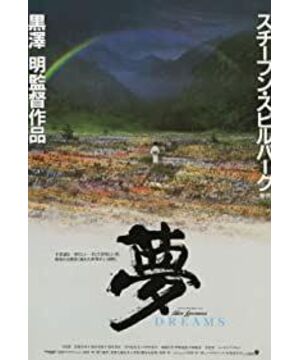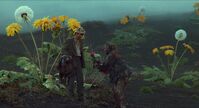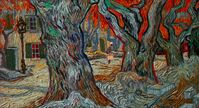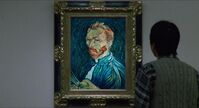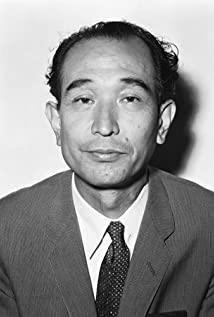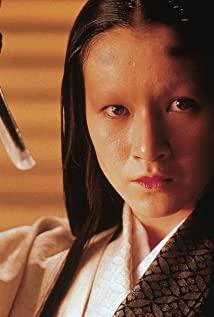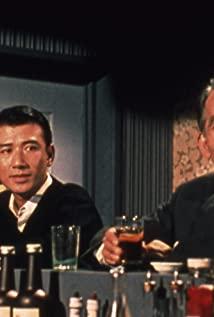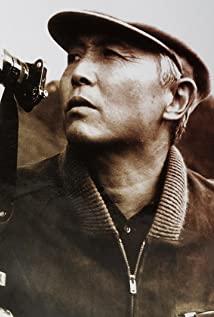The movie "Dream" is composed of eight dreams. At the beginning of the movie, it was introduced as a dream of "I", so the protagonist in each dream is "I", the director. The eight dreams are named "Sun Rain", "Taoyuan", "Blizzard", "Tunnel", "Crow", "Red Fuji", "Devil May Cry" and "Waterwheel Village" in turn. Let's talk about them one by one and feel the culture and beliefs displayed by the director.
First, "sun rain". A boy who spied on a fox’s wedding and was kicked out of his home, either hanged himself with a dagger, or apologized to the fox for forgiveness. In desperation, the boy went to the end of the rainbow to find the fox. In the last scene, the boy was driving under a rainbow sky with a dagger in his arms, walking in the sea of flowers, drifting away... This dream was over, and it was really incomprehensible at the time.
But when the second dream was halfway through, I knew it. The second story, "Taoyuan". In order to track the strange girl, the little boy ran to Taoyuan, which had been cut into a slope of soil. Taoyuan was a stepped slope, where the little boy was questioned by the peach tree undead. The little boy's love for Taoyuan touched the dead souls of the peach tree, and once again saw the beauty of the peach blossoms in full bloom.
When the second dream story developed to the peach tree undead questioning stage, the meaning of the first dream came to the surface. The boy peeping at the fox's wedding is actually a metaphor for human beings' initial prying and discovering of nature. The fox is a metaphor for nature. In fact, animals such as foxes were used as metaphors for nature many times in Japanese film culture. For example, in 1994, the animated film "Various Tanuki" written by Hayao Miyazaki. The civet cat is a metaphor for nature. I wonder if this was inspired by the 1990 movie "Dream".
Here, in fact, dream is a manifestation of culture. In Japanese culture, there are many legends about foxes, which have become a cultural symbol. When the little boy peeped at the tanuki wedding ceremony, the characters in the dreams were dressed in traditional Japanese costumes, and the rhythm of the music with a strong Japanese national charm, took a few steps and turned around. This can be said to be a demonstration of Japanese national culture: costumes, music, ceremonies, dances... This is the dream of "I", a dream of deep Japanese flavor. This is a manifestation of Kurosawa Akira's love for Japanese traditional culture and his consistent style. His dream is also full of Japanese culture, so his dream is culture, Japanese culture. The Japanese culture has been carved too deeply in the director's heart, and it has become a kind of belief.
In fact, this is not the point of the first dream. The first dream "Sun Rain" and the second dream "Taoyuan" are inseparable. The more obscure content in "Sun Rain" is displayed more nakedly in "Taoyuan". That is the destruction of the environment by mankind. Perhaps this topic is not new at the moment. But "Dream" is a 1990 movie, at that time director Akira Kurosawa had already paid great attention to environmental issues.
In "Taoyuan", the director used a very long shot to show the scene of the peach tree undead dancing. This is an emotional cushion. In the dance, the peach petals gradually dance in the air, drifting more and more densely, and finally show There was a sea of flowers. Perhaps influenced by traditional Eastern culture, Eastern directors like to use long shots. Because what we pay attention to is freehand brushwork, implicit expression, and gradual progress of emotions. The long lens can just play such an effect. In addition, the long lens also adds a sense of sacredness to this picture. And when the splendor passed, in a blink of an eye, only the bare soil slopes and those naked and lonely tree roots remained. The boy stared at the only little peach blossom that remained, and tears couldn't help streaming down. And now when we face the filthy river, the bare hillside, and the cracked ground, how many tears do we shed? It was the director's tears that fell. This was exactly what he wanted to confide in. Needless to say, tears were enough.
And one or two dreams are just the expression of a belief in the director's heart-fearing nature. This is more obvious in subsequent dreams.
Third, the "blizzard". Several mountaineering explorers were struggling to find their camp on the plateau snow-capped mountains in the face of the blizzard. At the beginning of the dream is a very long scene without dialogue. What is shown to us is: gray tones, dense wind and snow, tangled faces, the most prominent sound effect is the heavy breathing of several climbers, and the combination of picture sound effects renders the depressed atmosphere extremely dense. The climber struggled in the thick snow and eventually fell. Human beings are so weak, insignificant, and weak in front of nature at this time. At this time, a woman put a coat on "I" who fell in the snow and said, "Snow is warm, and ice is hot". The wind and snow gradually increased, "I" did not want to be buried by the snow and struggled to get up, but the woman held on to "I" to prevent me from getting up. In the end, the blizzard blew her up into the sky, turning her into a plain-clothes, drifting away in the wind.
Who deceived "me" like this? Who is holding "I"? "I" refers to human beings, and that woman is human blind self-confidence and proud wisdom. It is they that make humans despise nature, and humans will drown in the snow under their deception, and finally die in the wind and snow. In fact, these two things, under the majesty of nature, will also be easily shattered and float into the distance, like those in plain clothes. Natural forces can dominate people's life and death, just like the end of this dream, the wind and snow stopped suddenly, the sky cleared, and the climbers found their camp and miraculously survived.
This is a warning. Warn people to face nature with gratitude. Don't challenge nature lightly, that is, hitting rocks with pebbles. This is still closely related to the first two dreams. "Sun Rain" and "Taoyuan" represent the destruction of nature by humans, while the latter dream "Blizzard" shows the power of nature and the overpower of human beings. This is in the same line, from which we can see how much the director Akira Kurosawa admires and respects nature. These dreams of his are actually one of his beliefs-fear of nature!
Fourth, "tunnels." The entire army was killed, and only the captain "I" survived. When passing through a tunnel, the soldiers of the third squadron who died appeared in front of me. Before entering the tunnel, a vicious wolfdog grinned at "I" with ammunition on his back. This is an irony! Why arm a dog? I think this is expressed behind the cruel war, and under the gorgeous arms, the animal desires are at work! The animal desires of human beings are the most terrifying, and the price to be paid is unpredictable!
"Go back, go back to rest in peace!" This was what "I" said to the dead Noguchi soldier. This is exactly the director's condolences for those soldiers who lost their lives in real wars! Then the words that "I" said to all the fallen soldiers of the third squad were exactly what the director wanted to express. Through my mouth, I expressed my disgust for war, sympathy for soldiers, and irony for political rulers. The images of the sacrificed soldiers in the dream are the images of good men with enthusiasm for serving the country, because Kurosawa knew that these soldiers were not wrong, and they were all victims of the war, for which they gave their young lives! In the end, "I" was leaving, but the mad dog appeared again, flaring his teeth and claws at me. In reality, the animal desires under war are still threatening many lives, just as this mad dog threatens "me"!
The director also used the dream of "tunnel" to reflect on historical wars and satirize the situation of international war in 1990, when the "Gulf War" broke out. It is not difficult to see that this dream is another belief of the director-peace!
Fifth, the "crow". I was admiring Van Gogh's paintings, and then I entered the paintings, and I found Van Gogh and had some exchanges. At the beginning, the dream showed several classic works by Van Gogh, "Starry Night", "Self-Portrait", "Crows Flying in the Wheat Field"... Then stopped in front of the painting "Al's Suspension Bridge", and "I" miraculously entered it. But "I" was not surprised to ask the peasant women by the river where Van Gogh lived. I really admire director Akira Kurosawa, because he restored the artistic conception of "Al's Suspension Bridge" very well. At that moment, I was a little surprised!
I found Mr. Van Gogh who was painting in the field. Van Gogh was played by the great director Martin Scorsese, which shows the artistic appeal of the director Akira Kurosawa. Mr. Van Gogh spoke very quickly about his feelings in painting, expressing his artistic madness. I think what I blurted out is also director Kurosawa's pursuit of film art. In the end, Mr. Van Gogh said, "Because I always can't draw my ears so I cut them!" This sentence fully reflects Van Gogh's harsh pursuit of art! This is what the director deliberately did, because if based on historical facts, Van Gogh's ears were still alive during the creation of "Al's Suspension Bridge". But after all, this is a dream. In addition to expressing his admiration for Van Gogh, the director also uses Van Gogh to express his artistic pursuit!
"I" then shuttled through Van Gogh's paintings, which coincided with Van Gogh's earlier statement that "I have swallowed these beautiful realms in my pen." Finally Van Gogh disappeared at the end of the wheat field, and a group of crows flew up and hovered over the wheat field. I also came out of the painting "The Wheat Field Where Crows Fly". In fact, from the beginning, I wondered why this dream was called "crow". Later, after watching this scene, I realized that the crow is actually a metaphor for Van Gogh. Because the crow is often a symbol of bad luck, people stay away from it, no one dares to approach it, it is lonely. And Van Gogh is just like this. His madness for art is beyond the scope of people's understanding. People think he is crazy, alienate him, and laugh at him. He is the lonely "crow".
This is exactly the director's understanding of this lonely master of art. The dream of "The Crow" also expresses Kurosawa Akira's understanding of different cultures and arts, thereby expressing his belief in art-perfection!
Sixth, "Red Fuji". The "Red Fuji" here does not refer to apples. It refers to the red Mount Fuji. In the dream, six nuclear power plants in Japan exploded, the sky was full of fireworks, and Mt. People are fleeing in unprotected places, and the air is filled with poisonous gas.
This dream shocked me, because it is really similar to the current situation. The nuclear power plant in Japan exploded due to the earthquake not long ago, and some areas were polluted. Of course, there is no exaggeration and seriousness in the movie. But this is also a coincidence. Director Akira Kurosawa's predictive skills are also good! I was the only one left in the dream, a mother with two children, and an engineer. Faced with the extreme fear of the dead mother, she yelled at the researchers of nuclear energy. The engineer was one of them. After apologizing, he threw himself into the sea and broke himself. I took off my clothes and tried my best to protect the mother and children.
In fact, the content of this dream has returned to the first three dreams. However, this time the spearhead is directed at the over-development and poor use of technology. Human beings are not directly destroyed by nature, but by their own technology. In addition to respecting nature and cherishing the environment, this is also a warning to people to reflect on themselves.
Seventh, "Devil May Cry." "I" came to a barren hillside, where various bombs and nuclear weapons were used in the war, which has become ecologically deformed. I met ogres with horns on their heads. They were also deformed due to radiation. I heard them crying with tears every evening.
This dream reflects a natural environmental problem, but the director connects the abuse of technology, war, and natural destruction. Because the problems of the real society are getting more and more complicated and entangled with each other. Looking at the ogre in my dream, I think of Mr. Lu Xun's novel "A Madman's Diary". The cannibalism in the book is feudal ethics. And who is the cannibal in this dream? Ogre? No, they are also victims. What really eats people is the deformed ecology brought about by war and technological abuse. But in the final analysis, it is still people's desire!
Since then, this question has been sublimated to another level, and what is expressed in the dream is not just a single level of meaning. The belief that the director wants to express is also the word-awe! Awe of nature and technology, human beings should be less conceited and more humble! An attitude of awe will make us go longer!
Eighth, "Waterwheel Village". I came to a paradise with beautiful mountains and rivers—Shuiche Village. People don't have modern technology, but they are simple and happy! It has the flavor of the peach blossom field described by Tao Yuanming! In my dream, I had a conversation with an old man. The old man’s tone was calm and talkative. At this time, I think the director is actually speaking. The old man said, "People are accustomed to a comfortable life. They think that the more convenient the better. Instead, they abandon the real good things." This is a naked expression of irony and warning to people in modern society. It's not like what an old rural man said. A clear director's self-explanation.
In the eighth dream, the director expressed two more thoughts: one, about death, two, about the
funerals being held in the ritual village, and we can’t see everyone’s sadness. The old man said: "We live a smooth and natural life. When we get older, we naturally die." "Work hard today, and there will be no regrets when we die tomorrow." This is a kind of calmness in the face of death. He was already 80 years old at that time. Akira Kurosawa also expressed his attitude towards death. Calm and calm.
In addition, the ritual of children laying flowers on the stones at the bridge has attracted my attention. The old man explained the allusion to me and said, "Most people don't know it anymore, but they still do it." Nowadays, people are playing down the ceremony more and more. Worship ceremony, festival ceremony and so on. Like the eight dreams in the whole film, the foxes in the first dream get married, the dance of the peach blossom undead in the second dream, and the funeral activities in the last dream are all rituals. The ceremony itself is a kind of culture, and it has a kind of meaning in itself. Isn't the scene of children offering flowers to the stone beautiful in itself? To downplay rituals is sometimes to downplay culture. This is also the inheritance and development of traditional culture that the director wants to express.
This dream is a scene of life. This is actually the director telling his own yearning for an ideal life, expressing his own inner attitude towards culture and belief in life! Is the director’s most lyrical point!
The eight dreams in the full text each have their own content to express. But it is not messy, nor is it completely independent. Let's sort out these eight dreams.
I think these eight dreams can be divided into two parts. The first five dreams are the first part, and the last three dreams are the second part.
The first part: The
first three dreams, layer by layer, express the love for the national culture, and more importantly, emphasize their first belief-the fear of nature. Then the fourth dream reveals the nature of war and at the same time put forward his second belief-peace. Then in the fifth dream, through visiting Van Gogh in the dream, he explained his artistic belief-tirelessness and perfection.
In addition, this is a way of thinking from the macroscopic nature to the war of mankind, and then to the self's artistic belief, from the macroscopic to the individual and from the objective to the self.
The second part: The
sixth dream, through the dream of the explosion of a nuclear power plant, links the natural environmental problems with the abuse of science and technology.
In the seventh dream, "I" witnessed the deformed ecological environment after the war and heard "Devil May Cry" with my own ears, linking the abuse of science and technology, war and natural environmental issues together. Reveal the root of the problem-human desire. In order to emphasize the word "awe" in one's own faith!
The eighth dream again mentioned the attitude towards death and culture, and the most important thing is to express the belief in one's life!
This division is because the connotation expressed by each dream in the first part is relatively independent while the second part does not individually emphasize a certain point of view and belief. Rather, the problem is sublimated, and each problem is comprehensively linked for display and discussion.
After watching the whole film, there is a sense of heartiness, the film is organized in an orderly manner, the emotional rhythm is well grasped, and the connotation level gradually progresses. The composition, music, sound effects, shooting skills, and depth of thought have all reached a certain level, and the subtle cooperation has produced the unique meaning of the film. This is a very mature film directed by Akira Kurosawa. And it is very personal! In this film, we spy on the dreamland of the director master, and appreciate Kurosawa's fascinating control over the movie in his later years, as well as the kind of great feelings of Kenji. Director Akira Kurosawa told us through this movie that it can be like this at the end of the film!
2011.4.5
View more about Dreams reviews


